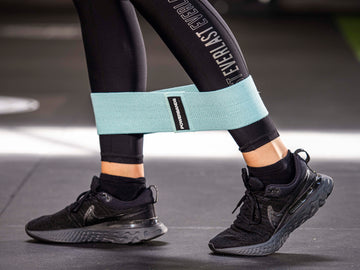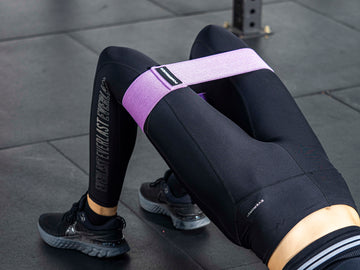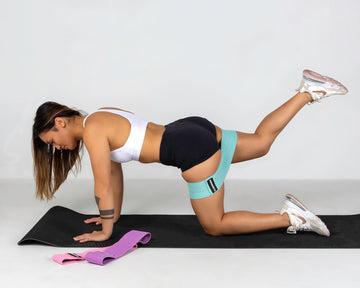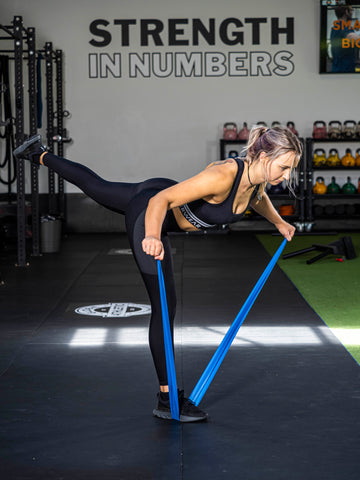Using resistance bands is a great way to strengthen muscles and improve flexibility. They're lightweight, easy to use, and effective for a variety of exercises. However, like any fitness tool, improper use can lead to injuries.
Understanding how to safely incorporate resistance bands into your workouts can make a big difference in preventing strains and sprains. Ready to learn how to stay injury-free while getting the most out of your resistance band workouts? Let's dive in.
Common Injuries Associated with Resistance Band Training
While resistance bands are generally safe, improper use can lead to some common injuries. One frequent issue is muscle strains. This happens when a muscle is stretched beyond its limit, causing small tears in the muscle fibres. Strains usually occur due to sudden, jerky movements or using a band that's too resistant for your current fitness level.
Another common injury is joint sprains, especially in the wrists, elbows, and shoulders. Sprains occur when ligaments, the tissues connecting bones, are overstretched or torn. This can happen if the band slips out of place or if you don't maintain proper form during exercises. Always ensure the band is securely anchored and that your joints maintain a neutral position.
Skin irritation can also be a problem, especially if the bands are made from materials that cause friction. To avoid this, make sure to use bands that are made from skin-friendly materials or wear long sleeves and gloves for protection.
By being aware of these common injuries, you can take steps to prevent them. Use appropriate resistance levels, anchor the bands securely, and focus on maintaining proper form throughout each exercise. These precautions will help you stay safe and get the most out of your resistance band workouts.
Essential Warm-Up Exercises to Prepare Your Muscles
Warming up before your workout is crucial for preventing injuries. It increases blood flow to your muscles, making them more flexible and ready to handle the stress of exercise. Here are some effective warm-up exercises to get you started:
1. Arm Circles
Stand with your feet shoulder-width apart and extend your arms out to the sides. Make small circles with your hands, gradually increasing the size of the circles. Do this for about 30 seconds in each direction. This exercise warms up your shoulders and arms.
2. Leg Swings
Stand next to a wall or a piece of sturdy furniture for support. Swing one leg forward and backward, gradually increasing the range of motion. Do this for 15-20 swings per leg. This exercise prepares your hips and legs.
3. Torso Twists
Stand with your feet shoulder-width apart and place your hands on your hips. Gently twist your torso from side to side, keeping your hips facing forward. Perform 15-20 twists. This warms up your core and lower back.
4. High Knees
Stand with your feet shoulder-width apart. Lift your knees towards your chest, alternating quickly between legs. Aim for 30 seconds of continuous motion. High knees boost your heart rate and get your entire body warmed up.
5. Resistance Band Pull-Aparts
Hold a resistance band with both hands, arms extended straight in front of you. Slide your hands apart, keeping your arms straight, and pull the band towards your chest. Perform 15-20 repetitions. This exercise targets your upper back and shoulders.
By incorporating these warm-up exercises into your routine, you'll be better prepared for your workout. Your muscles will be more flexible, and your risk of injury will be significantly reduced, allowing you to perform at your best.
Proper Techniques for Safe Resistance Band Movements
Getting the most out of resistance band workouts while avoiding injury hinges on using proper technique. Correct form ensures that you target the right muscle groups and don’t put unnecessary strain on your joints and ligaments. Here are some tips to help you maintain safe and effective practice:
1. Anchor Bands Securely
Make sure your resistance bands are anchored securely to prevent them from snapping back or slipping out of place. Use designated attachment points like door anchors or sturdy fixtures.
2. Maintain a Neutral Spine
Keep your back straight and avoid hunching or arching. A neutral spine protects your lower back and encourages proper alignment throughout your body.
3. Controlled Movements
Perform each exercise slowly and deliberately. Quick, jerky motions can increase the risk of strains and don’t engage muscles as effectively as controlled movements. Focus on both the concentric (lifting) and eccentric (lowering) phases.
4. Even Tension
Ensure the resistance band has equal tension throughout your exercises. Uneven band tension can lead to imbalances and possible injuries.
5. Proper Grip
Hold the band firmly but not too tightly. A relaxed grip helps to avoid unnecessary tension in your hands and forearms.
By applying these techniques, you will make your workouts more efficient and significantly reduce the risk of injury. Safe movements protect your body and allow for continuous improvement over time.
Tips for Post-Workout Recovery and Injury Prevention
Post-workout recovery is just as important as the workout itself. Proper recovery helps your muscles heal and get stronger, reducing the likelihood of injury in future sessions. Here are some tips to include in your post-workout routine:
1. Stretching
After your workout, spend time stretching the muscles you’ve just worked. Hold each stretch for about 20-30 seconds. This helps to improve flexibility and reduce muscle tension.
2. Foam Rolling
Use a foam roller to massage sore muscles and release tight spots. Foam rolling can relieve muscle knots and improve blood flow, speeding up recovery.
3. Hydration
Drink plenty of water before, during, and after your workout. Staying hydrated keeps your muscles functioning properly and helps to flush out toxins.
4. Balanced Nutrition
Eat a balanced meal or snack with protein and carbohydrates within an hour after your workout. This aids muscle repair and replenishes your energy levels.
5. Rest and Recovery
Make sure to include rest days in your workout schedule. Your muscles need time to recover fully. Overtraining can lead to fatigue and increase the risk of injury.
6. Listen to Your Body
Pay attention to how your body feels after a workout. If you experience unusual pain or discomfort, it may be a sign you need more rest or that your technique needs adjustment.
Incorporating these recovery tips ensures your body remains in peak condition, ready for your next resistance band workout.
Conclusion
Making resistance band training safe and effective involves understanding common injuries, warming up properly, maintaining correct technique, and focusing on recovery. When you pay attention to these key areas, you can enjoy all the benefits of resistance band exercises without the risk of injury.
Looking to optimise your workouts with the best resistance bands in Australia? Explore our range at POWERBANDS® today for high-quality resistance bands that suit all your fitness needs. Start your journey towards safer, more effective training today!








